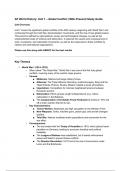AP World History: Unit 7 – Global Conflict (1900–Present) Study Guide
Unit Overview:
Unit 7 covers the significant global conflicts of the 20th century, beginning with World War I and
continuing through the Cold War, decolonization movements, and the rise of new global powers.
This period is defined by rapid political, social, and technological changes, as well as the
unprecedented scale of violence and destruction. It explores the causes and consequences of
wars, revolutions, and nationalist movements, as well as the responses to these conflicts by
nations and international organizations.
Please use this along with AMSCO for the best results
Key Themes
1. World War I (1914–1918):
○ Often called "The Great War," World War I was one of the first truly global
conflicts, involving many of the world's major powers.
○ Causes:
■ Militarism: Nations built large military forces.
■ Alliances: The Triple Alliance (Germany, Austria-Hungary, Italy) and the
Triple Entente (France, Russia, Britain) created a tense atmosphere.
■ Imperialism: Competition for colonies heightened tensions between
European powers.
■ Nationalism: Ethnic groups sought independence (e.g., Slavic
nationalism in the Balkans).
■ The assassination of Archduke Franz Ferdinand of Austria in 1914 set
off a chain reaction that led to war.
○ Key Characteristics:
■ Trench Warfare: Stalemate and high casualties on the Western Front.
■ New Weapons: Tanks, machine guns, poison gas, and aircraft changed
warfare.
■ Total War: Nations mobilized entire populations and economies for the
war effort.
○ Consequences:
■ The war ended with the Treaty of Versailles in 1919, which placed harsh
penalties on Germany, leading to economic hardship and political
instability.
■ The League of Nations was established, but it lacked enforcement
power and failed to prevent future conflicts.
■ The Russian Revolution (1917) led to the rise of communism under
Lenin and the Bolsheviks.
, 2. The Interwar Period (1919–1939):
○ The period between the wars was marked by economic instability, particularly
with the Great Depression of 1929, which caused worldwide economic hardship.
○ Rise of Totalitarian Regimes:
■ Fascism in Italy under Mussolini and Nazism in Germany under Hitler
emerged, both promoting authoritarianism, militarism, and nationalism.
■ Communism in the Soviet Union under Stalin consolidated power,
leading to widespread purges and state control of the economy.
■ Appeasement: Western democracies, particularly Britain and France,
initially sought to avoid conflict by appeasing aggressive powers like
Germany and Japan.
3. World War II (1939–1945):
○ The deadliest conflict in human history, involving most of the world's nations and
resulting in the deaths of tens of millions.
○ Causes:
■ The aggressive expansion of Germany, Italy, and Japan. Hitler's
invasion of Poland in 1939 triggered the war in Europe.
■ Failure of the League of Nations and the policy of appeasement
emboldened dictators.
○ Key Events:
■ Blitzkrieg tactics: Germany's rapid conquest of much of Europe.
■ The Holocaust: The Nazi regime's systematic genocide of six million
Jews, along with millions of others, including Roma, disabled individuals,
and political opponents.
■ Pearl Harbor (1941): Japan’s attack on the U.S. brought America into the
war.
■ D-Day Invasion (1944): Allied forces landed in Normandy, France, to
begin the liberation of Europe.
■ The war ended in 1945 with the defeat of Germany in Europe and the
dropping of atomic bombs on Hiroshima and Nagasaki by the U.S.,
forcing Japan's surrender.
○ Consequences:
■ The creation of the United Nations (UN) to prevent future conflicts.
■ The beginning of the Cold War between the United States and the Soviet
Union.
■ The global decolonization process accelerated, as European powers were
weakened, and many colonies sought independence.
4. The Cold War (1945–1991):
○ A period of ideological conflict between the United States and the Soviet Union,
characterized by political tension, military rivalry, and proxy wars rather than
direct confrontation.
○ Key Concepts:
■ Containment: U.S. policy aimed at preventing the spread of communism
(e.g., the Truman Doctrine and Marshall Plan).




